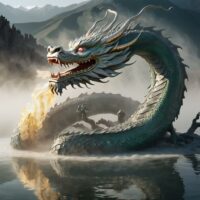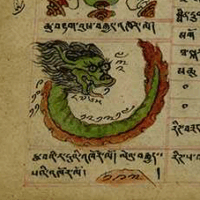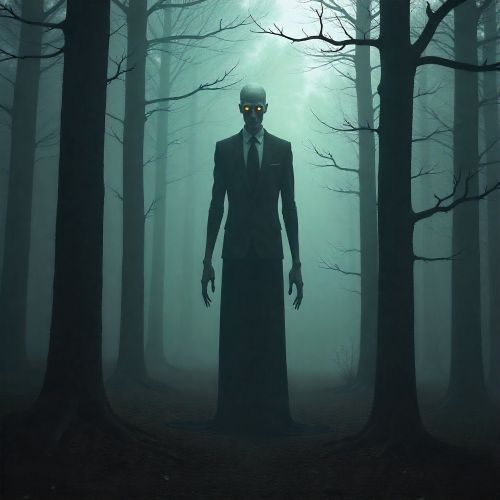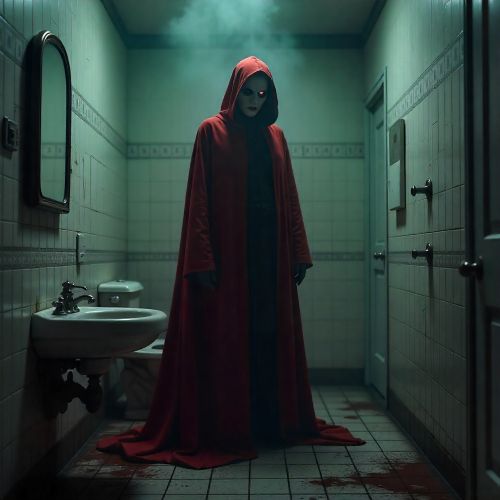Luu : The Water Dragon
Listen
At a glance
| Description | |
|---|---|
| Origin | Mongolian Mythology |
| Classification | Animals |
| Family Members | N/A |
| Region | Mongolia |
| Associated With | Water |
Luu
Introduction
In the mystical landscape of Mongolian mythology, Luu emerges as a revered figure representing water’s sacred power. Although dragons in Mongolia are not as visually dominant as in neighboring China, they hold profound spiritual and symbolic significance. Known as the king of water, Luu embodies the mystical forces that govern natural balance, particularly water sources like rivers, lakes, and underground springs. Rooted in Tengerism and Mongolian shamanistic beliefs, Luu is more than a creature of myth—it is a force of nature whose respect is deeply tied to wellbeing and environmental harmony. This article delves into the many facets of Luu, shedding light on its identity, lore, and contemporary relevance.
Physical Traits
Descriptions of Luu are often drawn from symbolic associations rather than literal depictions. In Mongolian tradition, dragons are rarely illustrated in detailed visual form but are often likened to serpents or large snakes—beings already imbued with sacred power. Luu is imagined as a long, scaled, sinuous creature with divine features such as horns or glowing eyes, echoing the qualities of dragons in Chinese and Tibetan traditions. These physical traits are symbolic more than anatomical, representing wisdom, elemental power, and a connection between the earthly and the spiritual. The association with snakes (known as mogoy) reinforces this visual identity, as snakes are viewed across Central Asia as miniature embodiments of dragons.
Family
Though direct familial lineages of Luu are not deeply elaborated in Mongolian texts, certain folktales give us insight into a broader mythological structure. In the well-known tale of “The Hunter-Boy,” the protagonist saves a white snake who later reveals herself as the daughter of the Dragon King—likely an incarnation of Luu. This story suggests that Luu may have a royal lineage, including children or emissaries that serve as guardians of specific water bodies. The concept of dragon families appears to be influenced by Chinese mythology, where dragons are organized in structured royal hierarchies. The overlap of these themes in Mongolian stories hints at a shared mythic ecosystem across Central and East Asia.
Other names
Luu is the primary name used in Mongolian to refer to dragon spirits. This term is derived from Classical Mongolian and has etymological roots tracing back to Old Turkic (lü) and further to the Chinese word lóng (龍). In different regional contexts and languages within Mongolia, Luu may also be referenced as Luz or Mogoy, particularly when the narrative emphasizes the serpent aspect of the dragon. These linguistic variations reveal the cultural interweaving of Mongolian, Turkic, and Chinese mythologies. Furthermore, Luu is one of the Four Sacred Animals in Mongolian cosmology, alongside the Snow Lion (Arslan), Garuda (Khangard), and Tiger (Bar), emphasizing its elevated status.
Powers and Abilities
Luu is not just a mythic figure; it is a powerful spirit believed to control the purity and abundance of water. In shamanic rituals, Luu is invoked to bring rain, prevent droughts, and protect rivers from contamination. Failure to honor the spirit of Luu is thought to result in “dragon illnesses”—mysterious diseases linked to polluted water or environmental disrespect. These ailments reflect the spiritual consequences of ecological negligence. Additionally, Luu is believed to guard treasures hidden in water bodies and caves, symbolizing a connection to both material wealth and spiritual insight. Some traditions even regard historical figures like Genghis Khan as incarnations or emissaries of dragon-spirits, elevating Luu’s influence into the political and imperial sphere. Through these roles, Luu represents protection, wisdom, and a divine bridge between the human world and the forces of nature.
Modern Day Influence
Although modern Mongolian society has largely secularized, the legacy of Luu endures in subtle yet meaningful ways. Archaeological findings—such as ornate dragon statues from Xiongnu-era tombs—highlight the dragon’s revered role in ancient Mongol aristocracy. The Mongolian calendar, which draws from Tibetan models, still includes the “Year of the Dragon,” symbolizing Luu’s ongoing cultural presence. In today’s shamanic practices, especially in rural areas, rituals honoring water spirits continue to acknowledge Luu. Ceremonial offerings, such as milk or dairy products, are made to water bodies, reaffirming the spiritual link between humans and aquatic forces. Luu is also depicted in art and clothing motifs, particularly in regions with strong Tibetan Buddhist influence, where dragons signify enlightenment and mastery over the ego. Even in literature and folklore, Luu often appears alongside Mongolia’s other sacred animals, symbolizing harmony with nature.
Beyond Mongolia, Luu’s identity finds resonance in Tibetan and Chinese cultures where dragons fulfill similar roles as elemental guardians. This cultural overlap suggests a broader pan-Asian reverence for water spirits and dragons as mediators between the physical and spiritual realms. In environmental conversations today, Mongolian mythology—through figures like Luu—provides a valuable lens to understand the spiritual stakes of ecological care. Respecting water not only ensures physical health but also aligns with ancient spiritual mandates passed down through generations.
Related Images
Source
Nassen-Bayer; Stuart, K. (1992). Mongol creation stories: man, Mongol tribes, the natural world and Mongol deities. Asian Folklore Studies, 51(2), 323–334. Retrieved from https://en.wikipedia.org/wiki/Mongol_mythology
Mongolian Sources (Chapter 3) – The Cambridge History of the Mongol Empire. (2024, January 1). Cambridge Core. Retrieved from https://www.cambridge.org/core/books/cambridge-history-of-the-mongol-empire/mongolian-sources/CE6ADFCA239D5D7D7A1966799FF1D883
Özdemir, Ş. (2024). Biran, M. & Kim, H. (Eds.). The Cambridge History of the Mongol Empire. Vol. I: History (pp. xxi+876); Vol. II: Sources (pp. 613). Cambridge: Cambridge University Press, 2023. ISBN: 978–1–107–11648–1. Journal of Old Turkic Studies, 8(2), 408. Retrieved from https://www.cambridge.org/core/books/cambridge-history-of-the-mongol-empire/339475953C6AECE567FA50F1AED951A7
Mongolian Mythology | Mythosphere. (2000, January 1). Folklore.earth. Retrieved from https://www.folklore.earth/culture/mongolian/
Mongolian Mythology – Gods and Monsters. (2024, February 15). Gods and Monsters. Retrieved from https://godsandmonsters.info/welcome-to-gods-and-monsters/mongolian-mythology/
Mongolian Dragons, Luu | Folklore & more — Rowena Jayne. (n.d.). Rowena Jayne. Retrieved from https://www.rowenajayneharris.com/interesting-things/mongoliandragon
Mythological semantics of snakes (mogoy), water spirits (luz) and dragon (luu) in the folklore of the Mongolian peoples. Traditional Culture, 211. (1968, January). ResearchGate. Retrieved from https://www.researchgate.net/publication/388547868_The_Rite_of_Seter_Tatakh_and_the_Cult_of_Water_Spirits_among_the_Mongolic_Peoples
Mind Map
Visualize how concepts connect
Frequently Asked Questions
What is lorem Ipsum?
I am text block. Click edit button to change this text. Lorem ipsum dolor sit amet, consectetur adipiscing elit. Ut elit tellus, luctus nec ullamcorper mattis, pulvinar dapibus leo.
What is lorem Ipsum?
I am text block. Click edit button to change this text. Lorem ipsum dolor sit amet, consectetur adipiscing elit. Ut elit tellus, luctus nec ullamcorper mattis, pulvinar dapibus leo.
What is lorem Ipsum?
I am text block. Click edit button to change this text. Lorem ipsum dolor sit amet, consectetur adipiscing elit. Ut elit tellus, luctus nec ullamcorper mattis, pulvinar dapibus leo.
What is lorem Ipsum?
I am text block. Click edit button to change this text. Lorem ipsum dolor sit amet, consectetur adipiscing elit. Ut elit tellus, luctus nec ullamcorper mattis, pulvinar dapibus leo.
What is lorem Ipsum?
I am text block. Click edit button to change this text. Lorem ipsum dolor sit amet, consectetur adipiscing elit. Ut elit tellus, luctus nec ullamcorper mattis, pulvinar dapibus leo.






